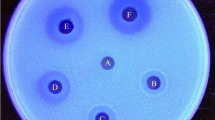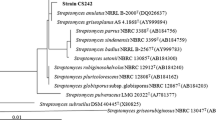Abstract
The advantage of usingStreptomyces griseus HUT 6037 in the production of chitinase or chitosanase is that the organism is capable of hydrolyzing amorphous or crystal-line chitin and chitosan according to the type of the substrate used. We investigated the effects of the enzyme induction time and chitin sources, CM-chitosan and deacetylated chitosan (degree of deacetylation 75–99%), on production of chitosanase. We found that this strain accumulated chitosanase when cells were grown in the culture medium containing chitosanaceous substrates instead of chitinaceous substrates. The highest chitosanase activity was obtained at 4 days of cultivation with 99% deacetylated chitosan. Soluble chitosan (53% deacetylated chitosan) was found to induce chitinase as well as chitosanase. The specific activities of chitinase and chitosanase were 0.91 and 1.33 U/mg protein at 3 and 5 days, respectively. From the study of the enzymatic digestibility of various degrees of deacetylated chitosan, it was found that (GlcN)3, (GlcN)4 and (GlcN)5 were produced during the enzymatic hydrolysis reaction. The results of this study suggested that the sugar composition of (GlcN)3 was homogeneous and those of (GlcN)4 and (GlcN)5 were heterogeneous.
Similar content being viewed by others
References
Kazuo, S. (1989) Development of chitin chitosan oligosaccharides.New Food Ind. 31: 17–25.
Koga, D. (1990) Chitinolytic enzymes.Sen-I Gakkaishi, 46: 581–585.
Takiguchi, Y. and K. Shimahara (1989) Productions and uses of N-acetylchitooligosaccharides and chitooligosaccharides by microorganism.Bio Industry 6: 616–621.
Joshi, S., M. Kozlowski, S. Richens, and D. M. Comberbach (1989) Chitinase and chitobiase production during fermentation of genetically improvedSerratia liquefaciens.Enzyme Microb. Technol. 11: 289–296.
Mitsutomi, M., A. Ohtakara, T. Fukamizo, and S. Goto (1990) Action pattern ofAcromonas hydrophila chitinase on partiallyN-acetylated chitosan.Agric. Biol. Chem. 54: 871–877.
Mitsutomi, M., H. Kidoh, H. Tomita, and T. Watanabe (1995) The action ofBacillus circulans WL-12 chitinase on partiallyN-acetylated chitosan.Biosci. Biotech. Biochem. 59: 529–531.
Mitsutomi, M., T. Hata, and T. Kuwahara (1995) Furification and characterization of novel chitinases fromStreptomyces griseus HUT 6037.J. Ferment Bioeng. 80: 153–158.
Ohno, T., S. Armand, T. Hata, N. Nikaidou, B. Henrissar, M. Mitsutomi, and T. Watanabe (1996) A modular family 19 chitinase found in the prokaryotic organismStreptomyces griseus HUT 6037.J. Bacteriol. 178: 5065–5070.
Monreal, J. and E. T. Reese (1969) The chitinase ofSerratia marcescens.Can. J. Microbiol. 15: 689.
Reid, J. D. and D. M. Ogrydziak (1981) Chitinase-over-producing mutant ofSerratia marcescens.Appl. Environ. Microbiol. 41: 664–669.
Roberts, R. L. and E. Cabib (1982)Serratia marcescens chitinase: one-step purification and use for the determination of chitin.Anal. Biochem. 127: 402–412.
Fuchs, R. L., S. A. McPherson, and D. J. Drahos (1986) Cloning of aSerratia marcescens gene encoding chitinase.Appl. Environ. Microbiol. 51: 504–509.
Ulhoa, C. J. and J. F. Peberdy (1992) Purification and some properties of the extracellular chitinase produced byTrichoderma harzianum.Enzyme Microb. Technol. 14: 236–240.
Neugebauer, E., B. Gamache, and R. Brzezinski (1991) Chitinolytic properties ofStreptomyces lividans.Arch. Mircobiol. 156: 192–197.
Robbins, P. W., C. Albright, and B. Benfield (1983) Cloning and expression of aStreptomyces plicatus chitinase (chitinase-63) inEscherichia coli.J. Biol. Chem. 263: 443–447.
Vyas, P. and M. V. Deshpande, (1989) Chitinase production byMyrothecium verrucaria and its significance for fungal mycelia degradation.J. Gen. Appl. Microbiol. 35: 343–350.
Zikakis, J. P. (1984)Chitin, Chitosan, and Related Enzymes. pp. 161–179. Academic Press, Orlando, USA.
Muzzarelli, R. A. A. (1977)Chitin. pp. 164–167. Pergamon Press, Oxford, UK.
Ohtakara, A., H. Ogata, Y. Taketomi, and M. Mitsutomi (1984) Purification and characterization of chitosanase fromStreptomyces griseus pp. 147–160, Academic Press, Orlando, USA.
Kim, K., C. W. Lee, E. Y. Lee, and S. M. Chang (1996) Optimal production ofN-acetyl-β-D-glucosamine using chitinolytic enzyme.Kor. J. Biotechnol. Bioene 11: 696–703.
Berger, L. R. and D. M. Reynolds (1958) The chitinase system of a strain ofStreptomyces griseus.Biochim. Biophys. Acta 29: 522–534.
Mima, S., M. Miya, R. Iwamoto, and S. Yoshikawa (1988) Highly deacetylation chitosan and its properties.Appl. Polymer Sci. 28: 1909–1917.
Sannan, T., K. Kurita, and Y. Iwakura (1976) Effect of deacetylation on solubility.Makromol. Chem. 177: 3589–3600.
Domszy, J. G. and G. A. F. Roberts (1985) Evaluation of infrared spectroscopic techniques for analyzing chitosan.Makromol. Chem. 186: 1671–1677.
Sannan, T., K. Kurita, K. Ogura and Y. Iwakura (1978) Studies on chitin: 7. I. R. spectroscopic determination of degree of deacetylation.Polymer 19: 458–459.
Tokura, S., N. Nishi, and A. Tsutsumi (1983) Studies on chitin 8. some properties of water soluble chitin derivatives.Polymer 15: 485.
Ohtakara, A. (1988) Chitosanase fromStreptomyces griseus.Method Enzymol. 161: 64–69.
Rondle, G. J. M. and W. T. J. Morgan (1955) The determination of glucosamine and galactosamin.J. Biochem. 61: 586–589.
Reissig, J. L., J. L. Strominger and L. F. Leloir (1955) A modified colorimetric method for the estimation ofN-acetylamino sugars.J. Biol. Chem. 27: 959–966.
Imoto, T. and K. Yagishita (1971) A simple activity measurement of lysozyme.Agric. Biol. Chem. 35: 1154–1156.
Bradford, M. M. (1976) A rapid and sensitive method for the quantitation of microgram quantities of protein utilizing the principle of protein-dye binding.Anal. Biochem. 72: 248–254.
Author information
Authors and Affiliations
Corresponding author
Rights and permissions
About this article
Cite this article
Kim, K., Ji, HS. Effect of chitin sources on production of chitinase and chitosanase byStreptomyces griseus HUT 6037. Biotechnol. Bioprocess Eng. 6, 18–24 (2001). https://doi.org/10.1007/BF02942245
Received:
Accepted:
Issue Date:
DOI: https://doi.org/10.1007/BF02942245




